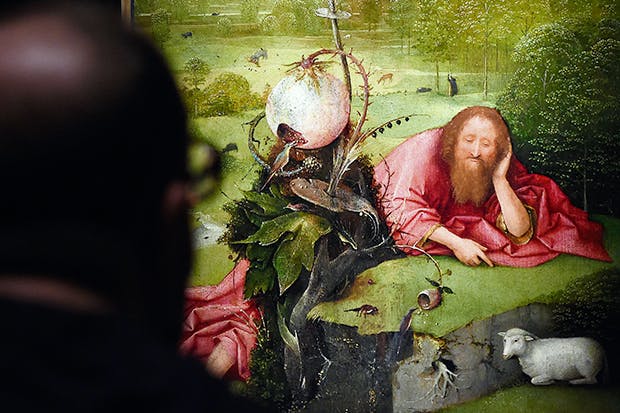If you hope to inspire an appreciation of Renaissance art in your children, look to Hieronymus Bosch. Ideally, your children will not be sensitive types, nor prone to nightmares, but if they can handle a little, or indeed quite a lot, of fantasy, Bosch will blow their tiny minds.
My four-year-old lad, Luca, definitely not a delicate chap, was deeply impressed by ‘The Garden of Earthly Delights’ when I showed him reproductions. He remains unmoved by Leonardo and bored rigid by Giotto, but Bosch snared him. I should hunt down a full-size poster and hang it in his room. I read somewhere that Leonardo DiCaprio snoozed beneath one as a boy, and look where it got him.
Bosch fascinates everyone though, not just impressionable infants. This year is the 500th anniversary of his death and he is being celebrated both in his home town of ‘s-Hertogenbosch and in Madrid, where much of his output resides. Our obsession with this extraordinary painter is such that he has become a cultural touchstone; any given scene of horror or debauchery, from Auschwitz to a boozed-up night in Manchester, will somewhere be compared by somebody to one of Bosch’s panels.
His paintings, rooted in a literal interpretation of scripture and embellished by layers of medieval Dutch folklore, continue to defy attempts to explain them. This obscurity of meaning is a great part of their appeal. We can only wonder in baffled amazement when we look at ‘The Temptation of Saint Anthony’ and see an armoured fish, complete with sword, sailing in a river past a donkey whose rump is an earthenware jug issuing liquid and, beside that, a rat-like creature being ridden by a crouched crone with a hideous stump, a sort of scaly parsnip, instead of legs. Plenty for poor old Anthony to think about there.
The German scholar Wilhelm Fraenger advanced a novel theory. He believed that Bosch was a member of the heretical sect known as the Adamites, prototype hippies who espoused free love and nudity in an effort to regain the sexual and moral liberty of Eden. For Fraenger, the central panel of ‘The Garden of Earthly Delights’, where masses of naked people crowd together to be fed berries by gigantic birds, ride an assortment of animals in an eternal circle and tumble with fish, man-size owls and each other, was not the blast against sin and depravity it is normally thought to be. Instead, he thought, it was a celebration of love and innocence that probably served as an altarpiece at secret Adamite ceremonies.
Fraenger’s theory has gained little traction over the years. The consensus tends to be that Bosch’s imaginings were the product of extreme religiosity in a time of flux, when orthodoxy was coming into conflict with the dawn of modernity. With Copernicus and Columbus tampering with the balance of knowledge and Martin Luther brewing up the Reformation, the certainty of hellfire may never have seemed closer.
Half a millennium of probing has thrown little light on Bosch’s disturbing carnival of the grotesque. Perhaps it is best to be like the four-year-old and revel in the glorious weirdness of it all.
Got something to add? Join the discussion and comment below.
Get 10 issues for just $10
Subscribe to The Spectator Australia today for the next 10 magazine issues, plus full online access, for just $10.














Comments
Don't miss out
Join the conversation with other Spectator Australia readers. Subscribe to leave a comment.
SUBSCRIBEAlready a subscriber? Log in